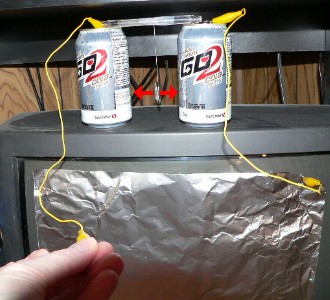  On this page we'll show you how to make a motor with just a few simple household items and a pair of empty pop cans.
On this page we'll show you how to make a motor with just a few simple household items and a pair of empty pop cans.
The items you'll need are shown at the left. They include the two pop cans, a pull-tab from one of the cans, tape, a sheet of aluminum foil, a short length of thread, a barrel from a cheap ballpoint pen, and two pieces of coated wire each about 30 cm long. We used wire test leads with alligator clips at the ends to make it easier to attach the wires, but if you don't have any of these, you can attach the wires with the tape. You'll also need access to an older television, since it's going to provide the power for our motor. Don't worry ... this is not a dangerous project. 

 The pictures above illustrate how to build the motor. Begin by removing the innards from the pen barrel, and taping about 5 cm of thread to the middle. Tie the other end of the thread to the pull-tab. With the two pop cans side by side, about 7-8 cm apart, lay the pen across their tops so the pull-tab hangs down half-way between, at about the middle of the cans. Attach one of the wires to the top of the can on the left. Attach the other wire to the top of the can on the right. Then fasten the other end of the right wire to the edge of the piece of aluminum foil. Now move the whole setup to the top of your TV, and press the foil smoothly to the screen of your television. (It's easier if the TV is off when you do this). Hold the left wire in your hand ... your body will act as a ground. Turn on the TV. The pull-tab will begin to move back and forth, making a clicking noise as it hits the can on each side. Your motor is running! Here's how it works.  The TV screen is full of excess electrons that have ended up there after being used to create a moving image on the TV. This makes the screen a source of high voltage.
The TV screen is full of excess electrons that have ended up there after being used to create a moving image on the TV. This makes the screen a source of high voltage.The aluminum foil spread over the screen collects this voltage, and sends a current of electrons through the motor and into your body. You won't feel anything. (Although it's high voltage, the current is quite small ... similar to the current in a static electric shock you get by scuffing your feet on a carpet and touching someone). Both cans become negatively charged because of the excess electrons. The pull-tab remains neutral because it is insulated from the current by the pen barrel. The negative charge on the right can repels the electrons that are in the pull-tab. These can't escape the pull-tab, but they move to the side away from the right can, leaving the side of the pull-tab closest to the right can positively charged. The pull-tab is then attracted toward the right can. When the pull-tab touches the right can, extra electrons from the can jump onto the pull-tab. This makes the pull-tab negatively charged too. Now it's repelled from the right can. Now the negatively charged pull-tab is moving toward the left can, which is also negatively charged. The negatively charged pull-tab repels electrons from the surface of the left can, which becomes positively charged. It now can attract the pull-tab. When the pull-tab touches the left can, the excess electrons jump off the pull-tab onto this can. This leaves the pull-tab neutrally charged, so it is free to swing back ... and then the process begins all over again. The motor will continue to run as long as the TV is left on to act as a source of electrons. Although the current involved is similar to a static electricity charge, we discovered that touching the foil or the cans while the motor is running, or even afterward, results in quite a large shock ... not dangerous, but certainly startling. |